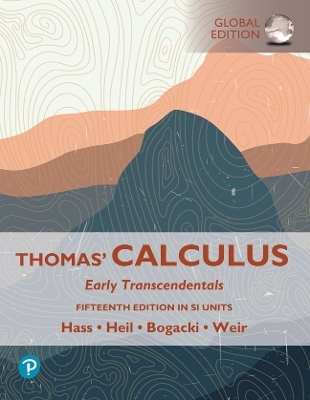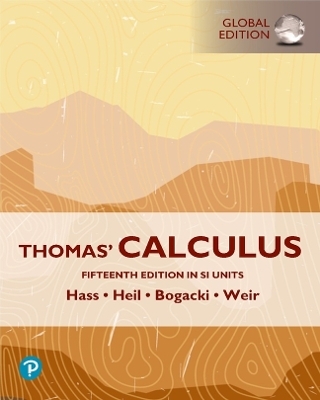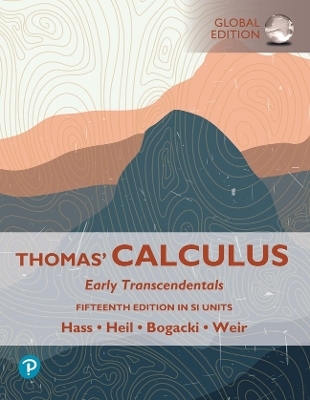
PowerPoint Slides for University Calculus
Pearson (Hersteller)
978-0-13-518942-9 (ISBN)
- Titel nicht im Sortiment
- Artikel merken
Joel Hass received his PhD from the University of California—Berkeley. He is currently a professor of mathematics at the University of California—Davis. He has coauthored six widely used calculus texts as well as two calculus study guides. He is currently on the editorial board of Geometriae Dedicata and Media-Enhanced Mathematics. He has been a member of the Institute for Advanced Study at Princeton University and of the Mathematical Sciences Research Institute, and he was a Sloan Research Fellow. Hass’s current areas of research include the geometry of proteins, three-dimensional manifolds, applied math, and computational complexity. In his free time, Hass enjoys kayaking. Christopher Heil received his PhD from the University of Maryland. He is currently a professor of mathematics at the Georgia Institute of Technology. He is the author of a graduate text on analysis and a number of highly cited research survey articles. He serves on the editorial boards of Applied and Computational Harmonic Analysis and The Journal of Fourier Analysis and Its Applications. Heil's current areas of research include redundant representations, operator theory, and applied harmonic analysis. In his spare time, Heil pursues his hobby of astronomy. Maurice D. Weir holds a DA and MS from Carnegie-Mellon University and received his BS at Whitman College. He is a Professor Emeritus of the Department of Applied Mathematics at the Naval Postgraduate School in Monterey, California. Weir enjoys teaching Mathematical Modeling and Differential Equations. His current areas of research include modeling and simulation as well as mathematics education. Weir has been awarded the Outstanding Civilian Service Medal, the Superior Civilian Service Award, and the Schieffelin Award for Excellence in Teaching. He has coauthored eight books, including the University Calculus series and Thomas’ Calculus. Przemyslaw Bogacki is an Associate Professor of Mathematics and Statistics and a University Professor at Old Dominion University. He received his PhD in 1990 from Southern Methodist University. He is the author of a text on linear algebra, to appear in 2019. He is actively involved in applications of technology in collegiate mathematics. His areas of research include computer aided geometric design and numerical solution of initial value problems for ordinary differential equations.
1. Functions
1.1 Functions and Their Graphs
1.2 Combining Functions; Shifting and Scaling Graphs
1.3 Trigonometric Functions
1.4 Graphing with Software
1.5 Exponential Functions
1.6 Inverse Functions and Logarithms
2. Limits and Continuity
2.1 Rates of Change and Tangent Lines to Curves
2.2 Limit of a Function and Limit Laws
2.3 The Precise Definition of a Limit
2.4 One-Sided Limits
2.5 Continuity
2.6 Limits Involving Infinity; Asymptotes of Graphs
Questions to Guide Your Review
Practice Exercises
Additional and Advanced Exercises
3. Derivatives
3.1 Tangent Lines and the Derivative at a Point
3.2 The Derivative as a Function
3.3 Differentiation Rules
3.4 The Derivative as a Rate of Change
3.5 Derivatives of Trigonometric Functions
3.6 The Chain Rule
3.7 Implicit Differentiation
3.8 Derivatives of Inverse Functions and Logarithms
3.9 Inverse Trigonometric Functions
3.10 Related Rates
3.11 Linearization and Differentials
Questions to Guide Your Review
Practice Exercises
Additional and Advanced Exercises
4. Applications of Derivatives
4.1 Extreme Values of Functions on Closed Intervals
4.2 The Mean Value Theorem
4.3 Monotonic Functions and the First Derivative Test
4.4 Concavity and Curve Sketching
4.5 Indeterminate Forms and L’Hôpital’s Rule
4.6 Applied Optimization
4.7 Newton’s Method
4.8 Antiderivatives
Questions to Guide Your Review
Practice Exercises
Additional and Advanced Exercises
5. Integrals
5.1 Area and Estimating with Finite Sums
5.2 Sigma Notation and Limits of Finite Sums
5.3 The Definite Integral
5.4 The Fundamental Theorem of Calculus
5.5 Indefinite Integrals and the Substitution Method
5.6 Definite Integral Substitutions and the Area Between Curves
Questions to Guide Your Review
Practice Exercises
Additional and Advanced Exercises
6. Applications of Definite Integrals
6.1 Volumes Using Cross-Sections
6.2 Volumes Using Cylindrical Shells
6.3 Arc Length
6.4 Areas of Surfaces of Revolution
6.5 Work
6.6 Moments and Centers of Mass
Questions to Guide Your Review
Practice Exercises
Additional and Advanced Exercises
7. Integrals and Transcendental Functions
7.1 The Logarithm Defined as an Integral
7.2 Exponential Change and Separable Differential Equations
7.3 Hyperbolic Functions
Questions to Guide Your Review
Practice Exercises
Additional and Advanced Exercises
8. Techniques of Integration
8.1 Integration by Parts
8.2 Trigonometric Integrals
8.3 Trigonometric Substitutions
8.4 Integration of Rational Functions by Partial Fractions
8.5 Integral Tables and Computer Algebra Systems
8.6 Numerical Integration
8.7 Improper Integrals
Questions to Guide Your Review
Practice Exercises
Additional and Advanced Exercises
9. Infinite Sequences and Series
9.1 Sequences
9.2 Infinite Series
9.3 The Integral Test
9.4 Comparison Tests
9.5 Absolute Convergence; The Ratio and Root Tests
9.6 Alternating Series and Conditional Convergence
9.7 Power Series
9.8 Taylor and Maclaurin Series
9.9 Convergence of Taylor Series
9.10Applications of Taylor Series
Questions to Guide Your Review
Practice Exercises
Additional and Advanced Exercises
10. Parametric Equations and Polar Coordinates
10.1Parametrizations of Plane Curves
10.2Calculus with Parametric Curves
10.3 Polar Coordinates
10.4 Graphing Polar Coordinate Equations
10.5 Areas and Lengths in Polar Coordinates
Questions to Guide Your Review
Practice Exercises
Additional and Advanced Exercises
11. Vectors and the Geometry of Space
11.1 Three-Dimensional Coordinate Systems
11.2 Vectors
11.3 The Dot Product
11.4 The Cross Product
11.5 Lines and Planes in Space
11.6 Cylinders and Quadric Surfaces
Questions to Guide Your Review
Practice Exercises
Additional and Advanced Exercises
12. Vector-Valued Functions and Motion in Space
12.1Curves in Space and Their Tangents
12.2 Integrals of Vector Functions; Projectile Motion
12.3 Arc Length in Space
12.4 Curvature and Normal Vectors of a Curve
12.5 Tangential and Normal Components of Acceleration
12.6 Velocity and Acceleration in Polar Coordinates
Questions to Guide Your Review
Practice Exercises
Additional and Advanced Exercises
13. Partial Derivatives
13.1 Functions of Several Variables
13.2 Limits and Continuity in Higher Dimensions
13.3 Partial Derivatives
13.4 The Chain Rule
13.5 Directional Derivatives and Gradient Vectors
13.6 Tangent Planes and Differentials
13.7 Extreme Values and Saddle Points
13.8Lagrange Multiplier
Questions to Guide Your Review
Practice Exercises
Additional and Advanced Exercises
14. Multiple Integrals
14.1 Double and Iterated Integrals over Rectangles
14.2 Double Integrals over General Regions
14.3 Area by Double Integration
14.4 Double Integrals in Polar Form
14.5 Triple Integrals in Rectangular Coordinates
14.6 Applications
14.7 Triple Integrals in Cylindrical and Spherical Coordinates
14.8 Substitutions in Multiple Integrals
Questions to Guide Your Review
Practice Exercises
Additional and Advanced Exercises
15. Integrals and Vector Fields
15.1 Line Integrals of Scalar Functions
15.2 Vector Fields and Line Integrals: Work, Circulation, and Flux
15.3 Path Independence, Conservative Fields, and Potential Functions
15.4 Green’s Theorem in the Plane
15.5 Surfaces and Area
15.6 Surface Integrals
15.7 Stokes’ Theorem
15.8 The Divergence Theorem and a Unified Theory
Questions to Guide Your Review
Practice Exercises
Additional and Advanced Exercises
16. First-Order Differential Equations (online at bit.ly/2pzYlEq)
16.1 Solutions, Slope Fields, and Euler’s Method
16.2 First-Order Linear Equations
16.3 Applications
16.4 Graphical Solutions of Autonomous Equations
16.5 Systems of Equations and Phase Planes
17. Second-Order Differential Equations (online at bit.ly/2IHCJyE)
17.1 Second-Order Linear Equations
17.2 Non-homogeneous Linear Equations
17.3 Applications
17.4 Euler Equations
17.5 Power-Series Solutions
Appendix
A.1 Real Numbers and the Real Line
A.2 Mathematical Induction AP-6
A.3 Lines and Circles AP-10
A.4 Conic Sections AP-16
A.5 Proofs of Limit Theorems
A.6 Commonly Occurring Limits
A.7 Theory of the Real Numbers
A.8 Complex Numbers
A.9 The Distributive Law for Vector Cross Products
A.10 The Mixed Derivative Theorem and the increment Theorem
Additional Topics (online at bit.ly/2IDDl8w)
B.1 Relative Rates of Growth
B.2 Probability
B.3 Conics in Polar Coordinates
B.4 Taylor’s Formula for Two Variables
B.5 Partial Derivatives with Constrained Variables
Odd Answers
| Erscheint lt. Verlag | 16.3.2022 |
|---|---|
| Sprache | englisch |
| Themenwelt | Mathematik / Informatik ► Mathematik ► Analysis |
| ISBN-10 | 0-13-518942-X / 013518942X |
| ISBN-13 | 978-0-13-518942-9 / 9780135189429 |
| Zustand | Neuware |
| Haben Sie eine Frage zum Produkt? |
aus dem Bereich


